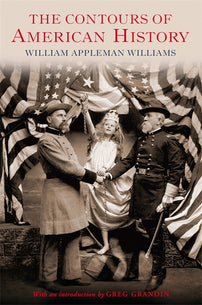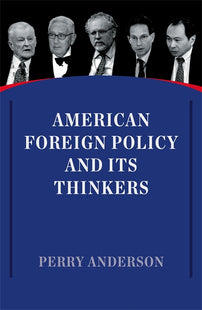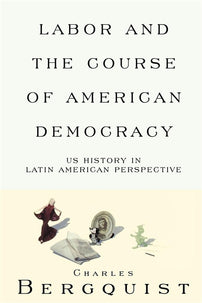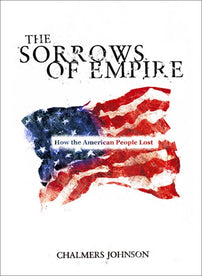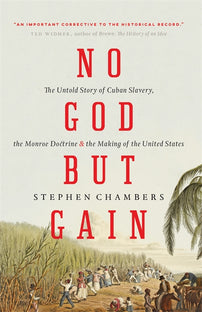History as a Way of Learning
William Appleman Williams criticizes common abuses of American history and explains his own method.

A classic essay in historical interpretation, William Appleman Williams' 1961 The Contours of American History, was republished by Verso in 2011 in a fiftieth anniversary edition, including an introduction by Greg Grandin.
In the excerpt below, which forms the preface to the book, Williams criticizes the abuses of American history then common among both historians and those outside of the field, and explains his own method.
"To study history is always to seek in some degree to get beyond the limitations and preoccupations of the present; it demands for success an effort of self-transcendence." — Arthur O. Lovejoy, 1939
Relieved and exhilarated by their triumph over the Axis Powers in 1945, Americans seemed to have assumed that their traditional dream of becoming a world unto themselves was about to be realized. Far from having become disillusioned (or isolationist), they appeared casually confident that their earlier visions of Manifest Destiny were materializing as the reality of the present. Though vaguely uneasy about the full extent of its powers, most Americans looked upon the atom bomb as a self-starting magic lamp; even without being rubbed it would produce their long-sought City on the Hill in the form of a de facto American Century embracing the globe.
It was generally taken for granted that such benevolent Americanization of the world would bring peace and plenty without the moral embarrassments and administrative distractions of old-fashioned empires. And so, having created the most irrational weapon known to man, Americans proceeded with startling rationality to abandon the mass army as their principal strategic weapon. Armed only with their bomb, they then generously offered to help everyone become more like themselves. “We are willing to help people who believe the way we do,” explained Secretary of State Dean Acheson, “to continue to live the way they want to live.”
Had Americans applied their intelligence, humanitarianism, and power to the paradox of plenty without purpose within their own society and to the needs and aspirations of their fellow humans throughout the world, it is possible that their self-centered dream would have been transformed into a vision of brotherhood among men. Instead, they calmly asserted that they had disarmed, a confusion of the truth so complete as to befuddle even their opponents. On the one hand, American leaders explained that The Bomb kept the barbarian at bay while he was collapsing under the economic and political pressures exerted by the United States. On the other hand, they righteously condemned his failure to disarm while they kept a monopoly of nuclear weapons. Their promises of self-restraint served only to add a touch of arrogance to the double standard of their morality, a morality as dangerous and destructive as their weapon.
Some years later, after the Russians accepted the American logic of disarmament-by-nuclear-fusion and produced their own hydrogen bomb, the United States was forced to confront its own dilemmas with more candor and concern. But even earlier, throughout an era which might be called The Years of Babbitt’s Confidence, Americans had become increasingly perplexed, anxious, and frustrated. Not even McCarthyism, a particularly virulent epidemic of the anti-intellectualism of the frontier, could cope with the harsh realities of a world in revolution. In attempting to exorcise their fears, overcome their spiritual and intellectual malaise, and resolve their dilemmas, Americans in surprising numbers next turned more formally and directly to history for an explanation of their predicament and a program (if not a panacea) for the future.
As a result, and despite the natural charms and cultivated coquetry of psychology, sociology, and economics, Clio became involved in another of her many affairs with a society in search of reassurance and security. American foreign service officers retired to write memoranda for today’s diplomacy in the form of history books while historians took leave of absence to become acting foreign service officers. Many businessmen underwrote the reconstruction of selected portions of their past, while some historians made a thriving business of carefully culled segments of the heritage of America. And convinced of the validity of the underlying assumptions of such activities, numerous communities legislated history into the curriculums of their schools.
Many observers interpreted this enthusiasm as a sign that America was solidly afoot on the road to salvation. Without denying the virtues and values of history, there is nevertheless considerable reason to doubt whether the evidence is that persuasive. Even the most casual review of this particular renaissance reveals the persistance of two phrases, “history shows” and “history proves,” used to establish ex post facto the validity of a policy or attitude already entertained by the writer. Instead of being treated as the study of the past and present in which thinking, reasoning, and reflection might lead to insights and perception, history appeared more often to be viewed as a grab bag from which to snatch footnotes for an a priori opinion.
But History is one of the most misleading — and hence dangerous—approaches to knowledge if viewed, or practiced, as a process of reaching back into the past for answers sufficient unto the present and the future. For although historical consciousness can be a powerful tool with which to improve our lives and our world, it is little more than a demonic sorcerer’s apprentice unless the history of which we become conscious is something more than a brief in defense of some particular proposal. The purpose of history is not to explain our situation so that we settle down as what C. Wright Mills has called Cheerful Robots in This Best Possible of All Worlds. Neither is its function to propel us into orbit around some distant Utopia. Indeed not. History’s great tradition is to help us understand ourselves and our world so that each of us, individually and in conjunction with our fellow men, can formulate relevant and reasoned alternatives and become meaningful actors in making history.
Considered in this light, History is a way of learning. As such, it begins by leaving the present; by going back into the heretofore, by beginning again. Only by grasping what we were is it possible to see how we changed, to understand the process and the nature of the modifications, and to gain some perspective on what we are. The historical experience is not one of staying in the present and looking back. Rather it is one of going back into the past and returning to the present with a wider and more intense consciousness of the restrictions of our former outlook. We return with a broader awareness of the alternatives open to us and armed with a sharper perceptiveness with which to make our choices. In this manner it is possible to loosen the clutch of the dead hand of the past and transform it into a living tool for the present and the future.
As with any such enterprise, this essay in review and interpretation is apt to be misjudged in two ways. In the first place, it is not intended to be, and does not offer, a detailed reconstruction of the American past. That work, which might be compared to the product of the research lab in the natural sciences, is a continuous process sustained by all historians. This essay draws extensively upon such investigations by other scholars. In addition, independent research in the primary sources has been pursued in many areas of the American experience. Basically, however, the essay is the result of standing back and thinking about the available knowledge of America’s past in an effort to grasp the nature and significance of the relationships — the causes and the consequences — of what is known. It is thus an effort to provide three things: (1) a fundamental description of the structure and circumstances — the reality — of American society at various periods; (2) a characterization of the definition and explanation of the world entertained by Americans at different stages in their development; and (3) various explanations of the way such views of the world arose out of the immediate and remembered reality and in turn changed that reality.
By its very nature, an essay of this type invites misunderstanding of a second kind. Any effort to comprehend and survey the history of a nation by defining and elucidating a few central outlooks and attitudes is risky because of the great difficulty involved in picking the crucial themes. Some concepts are so huge and spongy that they absorb everything; when squeezed they squirt a never-ending stream of homogenized tables of contents. Others are so narrow and hard that they leave nothing but a peep-hole into the garden of evidence; the focus is superb but the field is often irrelevant.
The tool used in the present study is the concept of Weltanschauung, or definition of the world combined with an explanation of how it works. Every sane adult has such an inclusive conception of the world which cuts across and subsumes personal motives, group interests, and class ideologies. This point needs to be emphasized, for in recent years many historians have relied extensively on the psychology of the irrational in developing their analyses and interpretations. As a result, they seem to have confused consciousness of purpose with conspiracy. Now neither contingency nor madness is absent from history, but the vast majority of significant figures on the stage of history act consciously and purposefully (if usually routinely) within their conceptions of the world. Hence to assert, or assume, that the choice of interpretations lies between irrationality, chance, and conspiracy is to distort the nature of history almost beyond recognition. History written from that point of view becomes little more than a bag of tricks dumped upon the living.
This essay reviews and attempts to make sense out of American history by reference to three conceptions of the world which are traditionally associated with economic thought and action. The approach is open to two criticisms: it can be charged that this means that all thought is economic, and it can be claimed that it implies that ideas have no life of their own. There are two answers to these caveats.
First, some ideas which originate as instruments of specific interests ultimately break their narrow bounds and emerge as broad, inclusive conceptions of the world. Herbert Spencer made this point in convincing fashion. “I do not think,” he answered a critic, “that laissez-faire is to be regarded simply as a politico-economical principle only, but as a much wider principle — the principle of letting all citizens take the benefits and evils of their own acts: not only such as are consequent on their industrial conduct, but such as are consequent upon their conduct in general.”
Secondly, it should be obvious that ideas persist for a long time after their immediate relevance is gone, and therefore may act as independent variables in later circumstances. For this reason, and because of the practical problem of organizing any written history, it is always an arbitrary choice as to which — reality or existing ideas — will be discussed first. This essay opens with an outline of an existing idea and proceeds to discuss the way it was altered fundamentally by circumstances.
Following this introduction, which deals with the rise and decline of British mercantilism during the two centuries prior to the revolution of 1776, American history is presented as being defined in three periods, each of which is characterized and powered by a basic view of the world. They are: The Age of Mercantilism, 1740–1828; the Age of Laissez Nous Faire, 1819–1896; and the Age of Corporation Capitalism, 1882–1960s. Within each of these epochs the interrelationships of ideas and reality are seen to develop according to a dynamic which is described as having several stages.
At this point the historian confronts his most specific problem of synthesis and presentation. Unless he breaks the process of change into phases he cannot write about it save in a constant going to and fro that exaggerates the diffuseness and tenuousness of reality. He can err by making reality too complex — too “thisey and thatey” — as well as by forcing it into an oversimplified schematic system. Yet by organizing his report or reconstruction in the form of stages he risks creating a jerky and artificial impression of what is in reality a continuous and interrelated process.
The present essay attempts to strike a balance between these dangers by defining enough stages to provide a sense and feel of the changes while at the same time describing the predominant outlook and practice of the age in question. Thus each of the three broad divisions opens with a section on the Triumph of the Rising Order, in which an effort is made to characterize the essential reality, assumptions, theory, and policies of the then accepted conception of the world. Since all views of the world arise during and out of an order that they replace, and cannot triumph save as the old order dies, these dominant ideas are confronted almost immediately with a reality different from the one used as data in their own construction. This confrontation, discussed as A New Reality for Existing Ideas, eventuates in a modus vivendi through a third stage, The Adaptation of the Accepted Order. So adjusted and established, the accepted outlook next literally transforms reality and in doing so gives birth to new assumptions and ideas. As this challenge moves toward its own ultimate triumph, however, the existing outlook ripens and fulfills itself in practical and intellectual affairs. Lest there be any misunderstanding, each of the three main epochs — of Mercantilism, of Laissez Nous Faire, and of Corporation Capitalism — is described, analyzed, and discussed under the following headings.
I. The Triumph of the Rising Order
II. A New Reality for Existing Ideas
III. The Adaptation of the Accepted Order
IV. The Transformation of Reality and the Inception of New Ideas
V. The Fulfillment of the Passing Order
Though it is possible and indeed accurate, therefore, to speak of an overriding outlook, an equal emphasis is placed on conflict and change, upon the efforts of men to recognize and direct or inhibit such changes, and upon the development of new explanations of reality which come ultimately to replace the formerly accepted order.
The method of history is neither to bypass and dismiss nor to pick and choose according to preconceived notions; rather is it a study of the past so that we can come back into our own time of troubles having shared with the men of the past their dilemmas, having learned from their experiences, having been buoyed up by their courage and creativeness and sobered by their shortsightedness and failures. We shall then be better equipped to redefine our own dilemmas and problems as opportunities and possibilities and to proceed with positive rather than negative programs and policies. This enrichment and improvement through research and reflection is the essence of being human, and it is the heart of the historical method.
Let us abstract ourselves from today’s predilections and tomorrow morning’s headlines, therefore, and begin again by entering the mind of Anthony Ashley Cooper, First Earl of Shaftesbury, as he grappled with the problem of ordering the British Empire after the Cromwellian Revolution. The time is the middle of the 17th century and the Age of Mercantilism is rising on the far- flung foundations of the Age of Discovery and Exploration. In his conscious and purposeful efforts to manage trade and the affairs of the colonies, Shaftesbury is struggling to deepen and consolidate a maturing conception of the world and to formulate programs and policies that will be appropriate and effective. He is of course concerned with his own power and fortune. But to stop there is to rest on the lowest rung of the ladder of understanding. Our concern is with his conception of the sources of that power, its relationship to the reality of his time, the purposes for which it can and should be used, and the best means for its employment.
[book-strip index="1" style="display"]
